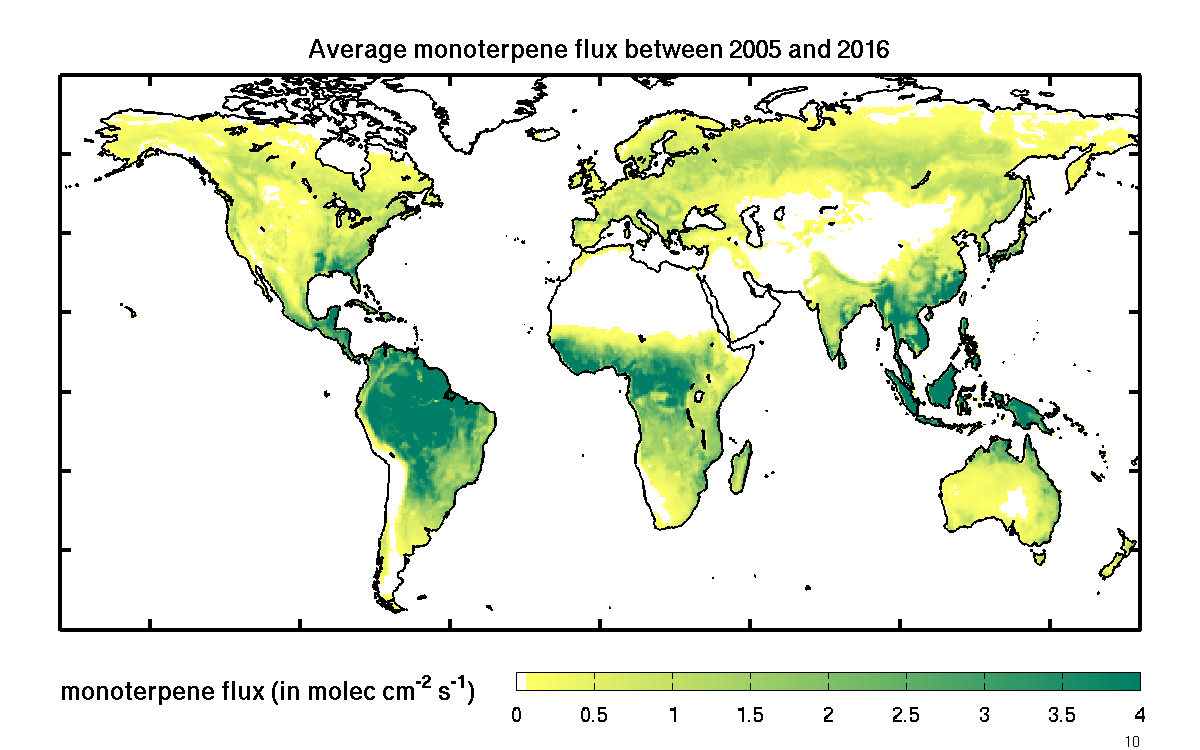MEGAN-MOHYCAN : Monoterpene emission inventory 2005-2016
View the data

Download
Below, we provide a global dataset from 2005 to 2016 of monthly averaged monoterpene emissions (in molec cm-2 s-1) in NetCDF format: 720 longitudes from 0.25 to 359.75° W, 360 latitudes from 89.75° N to 89.75° S, 12 months. Monoterpenes emissions are the sum of α-pinene, β-pinene, limonene, ocimene, myrcene, sabinene and 3-carene.
About the dataset
Based on ERA-Interim meteorological fields, the MEGANv2.1 emission model and the MOHYCAN multi-layer canopy environment model (Guenther et al. 2006, 2012, Müller et al. 2008, Bauwens et al. 2018), biogenic emissions are calculated over 2005-2016 using the expression : Flux=EF * [(1-LDF) * gamma_TLI * gamma_LAI + LDF * 0.55 * gamma_TLD * gamma_P * LAI ] * gamma_age * gamma_SM, where EF (mg m-2 h-1) is the emission factor under standard conditions (Guenther et al. 2006), and LDF is the light-dependent fraction of the emissions (Guenther et al. 2012).
The response to temperature (T), solar radiation (P), leaf age, soil moisture (SM), and leaf area index (LAI) are accounted for by the activity factors gamma. The calculation of light attenuation and leaf temperature in the different layers accounts for the LAI and distinguishes between seven plant functional types (broadleaf evergreen/deciduous trees, needleleaf evergreen/deciduous, trees, shrub, grass, and crops).
The MOHYCAN model calculates the temperature of sunlit and shade leaves and visible and near-infrared solar radiation fluxes at each canopy layer based on distributions of solar downward radiation, air temperature, relative humidity and wind speed at canopy top as well as of cloud cover provided by ERA-Interim ECMWF analyses. Leaf area index between 2005 and 2016 is obtained from daily MODIS 8-day 294 (collection 5) product at 1 km2 resolution.
References
- Bauwens, M., Stavrakou, T., Müller, J.-F., Van Schaeybroeck, B., De Cruz, L., De Troch, R., Giot, O., Hamdi, R., Termonia, P., Laffineur, Q., Amelynck, C., Schoon, N., Heinesch, B., Holst, T., Arneth, A., Ceulemans, R., Sanchez-Lorenzo, A., and Guenther, A.: Recent past (1979–2014) and future (2070–2099) isoprene fluxes over Europe simulated with the MEGAN-MOHYCAN model (2018), Biogeosciences, accepted.
- Dee, D. et al. (2011) The ERA-Interim reanalysis: Configuration and performance of the data assimilation system. Q. J. R. Meteorol. Soc. 137(656), 553–597.
- Guenther, A., Karl, T., Harley, P., Wiedinmyer, C., Palmer, P. I. and Geron, C. (2006). Estimates of global terrestrial isoprene emissions using MEGAN (Model of Emissions of Gases and Aerosols from Nature). Atmospheric Chemistry and Physics, 6 (11), 3181-3210.
- Guenther, A., Jiang, X., Heald, C. L, Sakulyanontvittaya, T., Duhl, T., Emmons, L.~K. and Wang, X. (2012). The Model of Emissions of Gases and Aerosols from Nature version 2.1 (MEGAN2.1): an extended and updated framework for modeling biogenic emissions. Geoscientific Model Development, 5 (6), 1471-1492.
- Müller, J.-F., Stavrakou, T. Wallens, S., De Smedt, I., Van Roozendael, M., Potosnak, M.~J. et al. (2008). Global isoprene emissions estimated using MEGAN, ECMWF analyses and adetailed canopy environmental model. Atmospheric Chemistry and Physics, 8, 1329-1341.
- Stavrakou, T., Müller, J.-F., Bauwens, M., De Smedt, I. Van Roozendael, M. and Guenther, A. (2018) Impact of short-term climate variability on volatile organic compounds emissions assessed using OMI Satellite formaldehyde observations, Goephysical Review Letters, in review.






